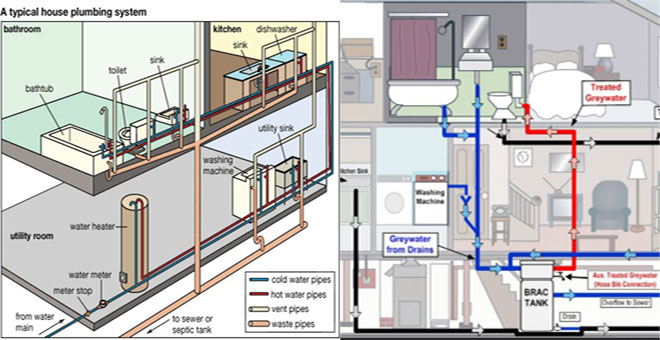An Overview to Your House's Plumbing System Anatomy
An Overview to Your House's Plumbing System Anatomy
Blog Article
We've uncovered this post on Plumbing Installation 101: All You Need to Know down the page on the net and believe it made sense to share it with you over here.

Comprehending just how your home's plumbing system works is crucial for every property owner. From providing tidy water for alcohol consumption, cooking, and bathing to safely getting rid of wastewater, a well-maintained plumbing system is critical for your family's health and wellness and convenience. In this extensive guide, we'll discover the detailed network that composes your home's pipes and deal tips on maintenance, upgrades, and managing usual issues.
Introduction
Your home's pipes system is more than simply a network of pipes; it's a complicated system that ensures you have accessibility to clean water and effective wastewater elimination. Understanding its elements and exactly how they interact can help you stop pricey repair work and make certain every little thing runs efficiently.
Basic Parts of a Plumbing System
Pipes and Tubes
At the heart of your plumbing system are the pipes and tubes that lug water throughout your home. These can be made of different products such as copper, PVC, or PEX, each with its advantages in regards to resilience and cost-effectiveness.
Components: Sinks, Toilets, Showers, and so on.
Components like sinks, toilets, showers, and bathtubs are where water is utilized in your house. Recognizing how these fixtures link to the pipes system aids in diagnosing issues and preparing upgrades.
Valves and Shut-off Points
Shutoffs regulate the circulation of water in your plumbing system. Shut-off valves are vital throughout emergencies or when you need to make repairs, permitting you to separate parts of the system without interfering with water circulation to the whole residence.
Water System
Key Water Line
The major water line links your home to the local water system or a personal well. It's where water enters your home and is distributed to various fixtures.
Water Meter and Stress Regulatory Authority
The water meter measures your water use, while a stress regulatory authority ensures that water flows at a safe pressure throughout your home's plumbing system, avoiding damage to pipes and components.
Cold Water vs. Warm water Lines
Recognizing the difference in between cold water lines, which provide water straight from the major, and warm water lines, which bring warmed water from the hot water heater, assists in fixing and planning for upgrades.
Drain System
Drain Water Lines and Traps
Drain pipelines bring wastewater away from sinks, showers, and bathrooms to the sewer or septic tank. Traps prevent sewer gases from entering your home and additionally catch particles that might trigger blockages.
Ventilation Pipes
Air flow pipelines enable air into the drainage system, protecting against suction that can reduce drain and trigger traps to empty. Correct air flow is vital for preserving the integrity of your plumbing system.
Relevance of Correct Drain
Guaranteeing proper water drainage protects against backups and water damage. Routinely cleansing drains and maintaining catches can stop costly fixings and prolong the life of your plumbing system.
Water Furnace
Kinds Of Water Heaters
Water heaters can be tankless or traditional tank-style. Tankless heating units warmth water on demand, while containers keep warmed water for immediate usage.
How Water Heaters Link to the Plumbing System
Recognizing how hot water heater connect to both the cold water supply and warm water circulation lines helps in detecting issues like inadequate warm water or leaks.
Upkeep Tips for Water Heaters
Regularly flushing your hot water heater to remove sediment, examining the temperature settings, and inspecting for leaks can prolong its life-span and enhance power efficiency.
Usual Pipes Concerns
Leakages and Their Reasons
Leakages can take place because of maturing pipes, loose fittings, or high water stress. Resolving leakages immediately stops water damage and mold growth.
Obstructions and Clogs
Blockages in drains and toilets are usually triggered by flushing non-flushable products or a buildup of oil and hair. Utilizing drain displays and being mindful of what drops your drains can avoid obstructions.
Indications of Plumbing Issues to Watch For
Low tide pressure, slow-moving drains, foul odors, or abnormally high water bills are indicators of prospective pipes problems that must be resolved without delay.
Pipes Maintenance Tips
Regular Inspections and Checks
Schedule annual plumbing evaluations to catch problems early. Try to find indications of leakages, rust, or mineral accumulation in taps and showerheads.
Do It Yourself Upkeep Tasks
Basic jobs like cleansing faucet aerators, checking for bathroom leaks utilizing dye tablet computers, or insulating exposed pipes in chilly environments can protect against major plumbing issues.
When to Call an Expert Plumbing Professional
Know when a pipes concern calls for specialist proficiency. Attempting complicated repair services without correct expertise can bring about even more damage and higher repair costs.
Upgrading Your Plumbing System
Reasons for Upgrading
Upgrading to water-efficient fixtures or replacing old pipes can enhance water high quality, decrease water expenses, and boost the worth of your home.
Modern Plumbing Technologies and Their Benefits
Check out innovations like wise leak detectors, water-saving commodes, and energy-efficient hot water heater that can conserve money and reduce ecological influence.
Expense Considerations and ROI
Compute the in advance costs versus long-term savings when thinking about plumbing upgrades. Many upgrades pay for themselves with minimized utility bills and fewer repairs.
Ecological Influence and Preservation
Water-Saving Components and Home Appliances
Installing low-flow faucets, showerheads, and commodes can dramatically lower water use without compromising performance.
Tips for Reducing Water Use
Straightforward routines like fixing leakages without delay, taking much shorter showers, and running full loads of washing and meals can save water and lower your energy expenses.
Eco-Friendly Plumbing Options
Consider lasting plumbing materials like bamboo for floor covering, which is durable and green, or recycled glass for countertops.
Emergency situation Readiness
Actions to Take Throughout a Plumbing Emergency situation
Know where your shut-off shutoffs are located and just how to shut off the supply of water in case of a ruptured pipeline or major leakage.
Value of Having Emergency Calls Helpful
Keep call info for local plumbing professionals or emergency solutions easily available for fast reaction throughout a plumbing situation.
Do It Yourself Emergency Fixes (When Suitable).
Temporary repairs like using air duct tape to patch a dripping pipe or positioning a bucket under a trickling faucet can decrease damage till a professional plumbing professional shows up.
Verdict.
Comprehending the makeup of your home's plumbing system encourages you to maintain it properly, saving money and time on repairs. By complying with regular maintenance regimens and staying notified about contemporary pipes technologies, you can guarantee your pipes system operates successfully for years to find.
Exploring Your Homes Plumbing Anatomy
Water Supply System
Main Water Line: This is where water enters your home from the municipal supply or a private well.
Water Meter: Typically located near where the main water line enters the property, it measures the amount of water used.
Shutoff Valve: It s crucial to know where this is in case of emergencies. It allows you to turn off the water supply to the entire house.
Pipes and Fittings: These distribute water throughout your home. Materials can include copper, PVC, or PEX.
Drain-Waste-Vent (DWV) System
Drains: Located in sinks, showers, and tubs, these carry wastewater away.
Traps: U-shaped pipes under sinks that hold standing water, blocking sewer gases from entering the home.
Vents: Pipes that lead from the DWV system to the outside, preventing vacuum formation and allowing gases to escape.
Sewer Line: Carries all wastewater from the home to the municipal sewer system or a septic tank.
Fixtures and Appliances
Sinks, Toilets, and Showers
Dishwashers and Washing Machines
Water Heaters
Maintenance Tips
Regularly check for leaks in exposed pipes and around fixtures.
Inspect the water heater annually for signs of wear.
Clean drains and traps to prevent clogs and odors.
Know how to shut off water to individual fixtures.
When to Call a Professional
Major leaks or burst pipes
Installation of new pipes or fixtures
Septic tank issues
Remodeling projects that involve plumbing changes
Conclusion
Understanding the anatomy of your home's plumbing is key to maintaining a functional and efficient system. Regular checks and knowing when to call in the experts can save you time, money, and stress.
https://www.mavyn.com/blog/exploring-your-homes-plumbing-anatomy

Exploring Your Homes Plumbing Anatomy
Water Supply System
Drain-Waste-Vent (DWV) System
Fixtures and Appliances
Maintenance Tips
When to Call a Professional
Conclusion
Understanding the anatomy of your home's plumbing is key to maintaining a functional and efficient system. Regular checks and knowing when to call in the experts can save you time, money, and stress.
https://www.mavyn.com/blog/exploring-your-homes-plumbing-anatomy
Do you enjoy reading about Exploring Your Homes Plumbing Anatomy? Try to leave a review below. We'd be happy to know your opinion about this entry. In hopes to see you back again later on. Do you know another person who is excited about the subject? Please feel free to share it. We value your readership.
Click Here Report this page